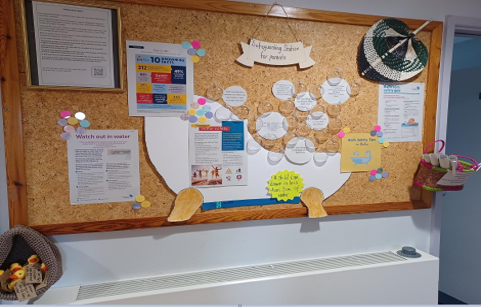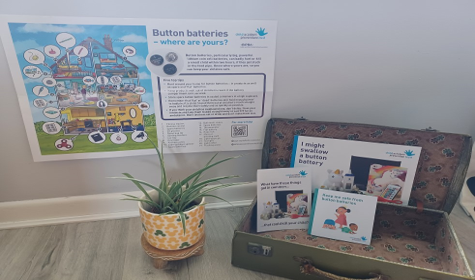Safeguarding
7. Sharing safeguarding messages with parents and carers
We are often asked about sharing safeguarding information with parents.
Some ways you could share awareness raising messages are:
- a specific information sharing area in your setting
- a parents information board
- a parents newsletter
You could share things like advice and support on avoidable accidents at home and when out and about.
Avoid topics such as categories of abuse and neglect or signs and symptoms. These are probably not the most useful to share with families.
Lancashire is a very large and diverse county, there has been a high number of significant injuries and even deaths of children as a result of traumatic incidents.
We have provided some ideas and resources you can use to share messages about preventing accidents.
We will continue to add more to this section with more helpful tips that you can share with parents.
Creative ways to share safety messages with families
Do:
- Make displays colourful, bright, easy on the eye and engaging.
- Deliver simple messages in a way that is easy to understand.
Do not:
- Overload displays with too much information.
Tone and topics
Ensure the message being shared is done in a helpful way and does not appear to parents or carers as if they are being told off.
Share top tips and advice that is achievable for families. Give some ideas and suggestions of how they can make reasonable adaptations to ensure the safety of their child.
Activities completed with children can also promote safety messages for parents or carers such as road and car seat safety topics.
Local information
Be familiar with your demographic area and cohort of families with children attending your setting. For example, are there many families in your area whose first language is not English? Do you have a high number of single parent families?
Consider the vulnerabilities within each of these types of groups. Be creative in sharing messages to reduce the risk of avoidable accidents at home.
Find out what resources and support agencies are available locally and let families know. You could even put together a little booklet of services and share this with families when you initially welcome them to your provision.
Ideas for displays
The Child Accident Prevention Trust website is great for resources. You can download some resources for free, others you can order as hard copies, sometimes for a charge. Below is the full list of topics they cover.
- Burns and scalds
- Button batteries
- Choking
- Dog safety
- Drowning
- Falls
- Fire safety
- Magnets
- Poisoning
- Road Safety
- Strangulation and suffocation
- Toy safety
Below are some themes of accidents in Lancashire:
- The most common reason for death is vehicle collision*
- Violence / maltreatment
- Animal attacks – dog bites
- Drowning - in the bath for young children and in open water environments for older children/teenagers
- Accidental strangulation - window blinds
- Falls – falling downstairs
- Choking
- Burns/electrocution
- Falling objects – insecure furniture eg TV, bookcases and tall cabinets
- There have been several incidents of young children swallowing laundry capsules as they are appealing like colourful jelly sweets
* There were no deaths to children when a car seat was used appropriately
General information about accidents
- Most accidents happen between late afternoon and early evening, in the summer, during school holidays and at weekends.
- Factors such as stress, death in the family, chronic illness, homelessness or moving home increase the likelihood of the child having an accident.
- Some happen when the usual routine is changed or when people are in a hurry.
- Distractions and inadequate supervision are often the cause of accidents.
- Poor housing and overcrowded conditions lead to increased numbers of accidents.
- Some accidents are caused by lack of familiarity with surroundings, for example, when visiting friends or relatives, or in holiday accommodation.
- High risk age groups are young children and teenagers.
Why do accidents happen to children?
Children are often absorbed in their own immediate interests, they can be oblivious to their surroundings. They only have a limited perception of the environment because of their lack of experience or development. They are not aware of the consequences of the many new situations that they encounter daily.
Small stature
This may prevent a child from seeing above an obstruction or being seen by an adult.
Inquisitiveness
Curiosity and a spirit of adventure may lead a child into danger.
Bravado and horseplay
Boys are particularly prone to showing off and overreaching their abilities, especially among friends. Many accidents are caused by horseplay involving pushing, shoving and wrestling.
Stress
Tensions at home and emotional upsets caused by temper, jealousy and over excitement may cause a child to run blindly into danger. Such action may even be deliberate to seek attention.
Inexperience
A child's interpretation of a situation may be inaccurate and adults looking after small children should be aware not to expect too much of them.
Inadequate supervision
Children need constant supervision. Medicines, pills and toxic substances should be locked away and fires and stairs should be guarded.

This picture board at the Early Years Child Development Centre Accrington is an example of water safety messages for parents.
You could replicate similar in your setting. The safety messages have come from The Child Accident Prevention Trust and The Royal Life Saving Society UK (particularly good for sourcing information for the safety of older children around water).
The messages in the bubbles on the board include:
- Bath seats can topple or your baby can slip out.
- Don't leave your baby alone in one for a moment.
- Get everything you need ready before bath time.
- Stay with your baby or young child all the time they are in the bath. Keep them in arm's length.
- Don't rely on your toddler to keep an eye on the baby while you pop out for a towel. They are too young to understand the danger.
- Drowning is silent.
We have also included a quiz for parents to take away and check their safety knowledge. This is available to download: Child Accident Prevention Trust bathroom safety quiz.
General messages
- The number of children drowning in the bath increased from 4 in 2019-20 to 12 in 2021-22. Seven of these deaths were of babies under one and, in five cases, bath seats were being used.
- Bath seats are not designed as safety devices and babies should not be left alone in them.
- In 82% of the cases the child had been left alone in the bath.
- The most common reasons for leaving a child alone are to take a phone call, leaving the room to get something e.g. a towel, confusion about who is supervising the child or attending to a sibling or other young children.
- A child can drown in less than 3cms of water.
- In the last five years, 119 children accidentally drowned in the UK.
There have been several tragic drownings of young children under the age of 1 year in the bath both nationally and locally.
A national case of a nine-month-old baby was found drowned in a few centimetres of bath water. He was left in his bath seat for just a few minutes while his mum fitted a plug-in diffuser in his bedroom to help his cold. She discovered him face down in the bath, with the seat unfixed. It had been firmly attached to the bath when she left. The coroner's report highlighted that "a bath seat must not be used as a safety device. Young children must always be supervised and be within arm's reach of an adult at all times".
We have also had the death of a baby girl aged seven months in Lancashire, due to drowning in the bath.
It’s not safe to pop out of the bathroom and leave a young child alone in the bath even for a few seconds. It is also easy to think that an older child can briefly look after a younger child or at least raise the alarm if something goes wrong. Older children shouldn’t be left in charge, they can’t be expected to know what to do if something happens and may not recognise the danger or react quickly enough. They may lack the strength or dexterity to get a younger child out of danger.
Water safety resources
- Canal & River Trust - Water safety for kids
- The Royal National Lifeboat Institution (RNLI) - Water safety advice and tips
- Royal Life Saving Society UK (RLSS UK) - Water safety at home
- Institute of Health Visiting – Water Safety in the home
- Child Accident Prevention Trust - Watch out in water fact sheet
- Child Accident Prevention Trust – Bath safety tips

The Child Accident Prevention Trust will send free resources for button battery safety.
Included in the pack is:
- One large house poster highlighting which devices in each room may have a button battery
- Several button battery flyers to share with families
- A button battery lesson plan and several books to further educate children.